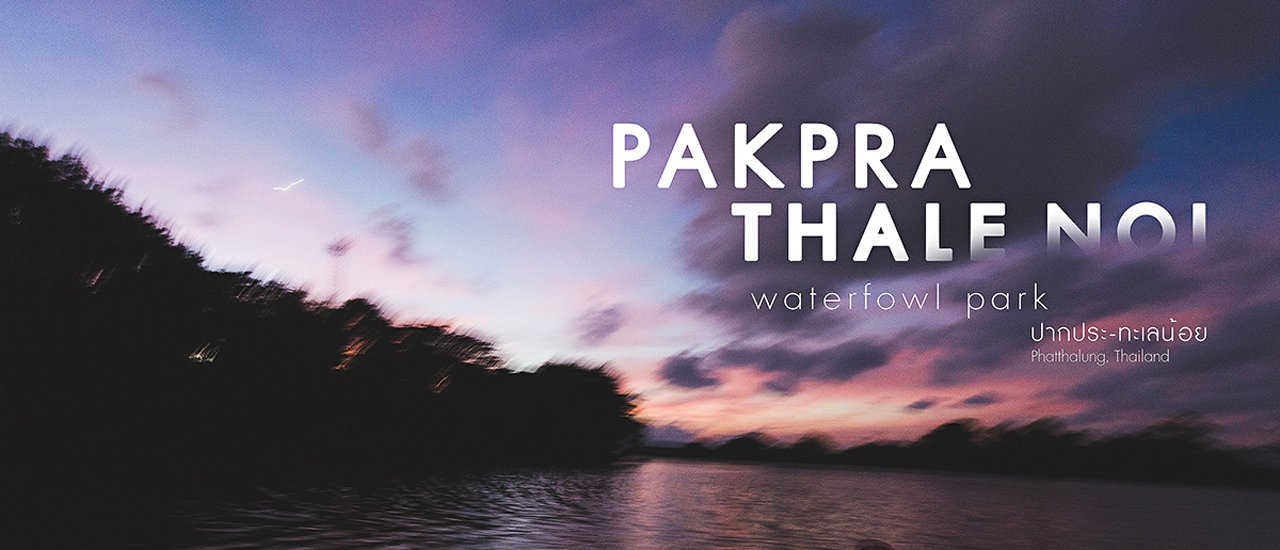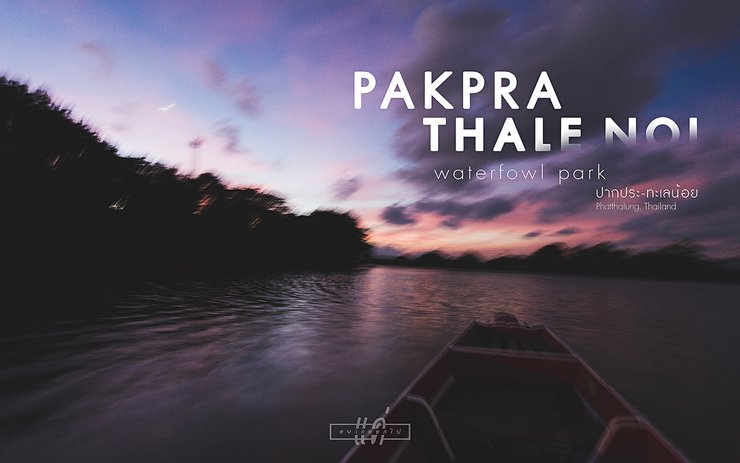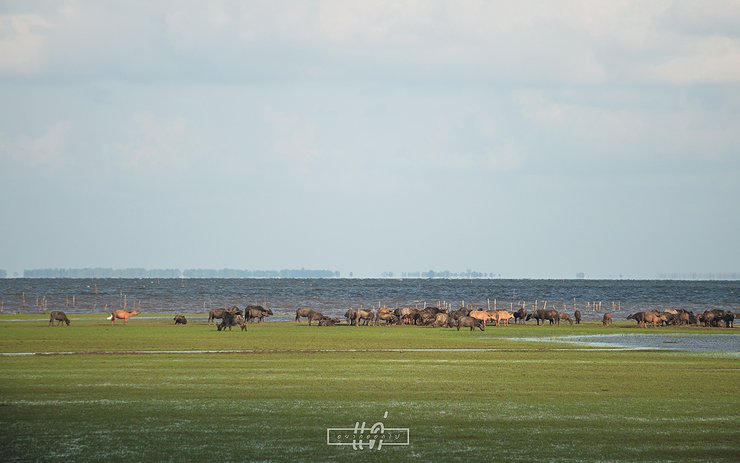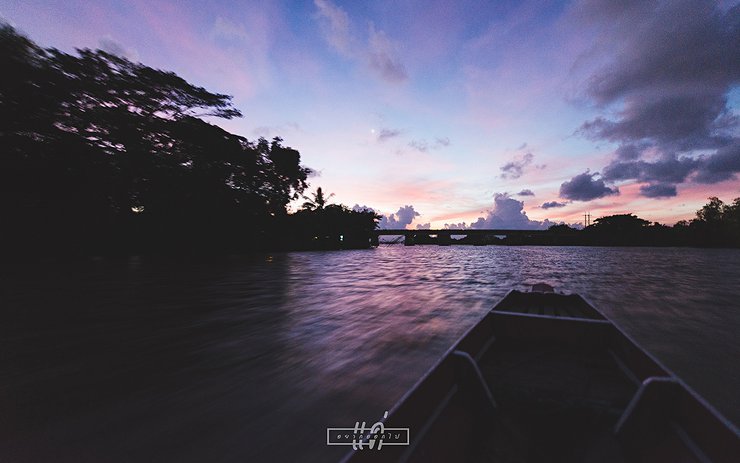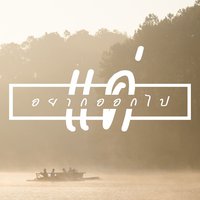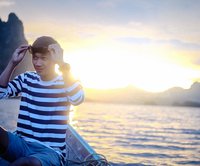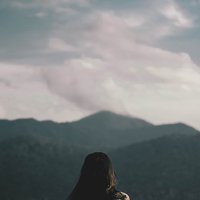
World's First Wetland in Thailand
Experience the beauty of nature with birdwatching, buffalo sightings, and a homestay stay.
Travel Dates: April 14-15, 2017

The journey begins with a 130km drive from Hat Yai to Pakpra, leading to the 80th Anniversary Bridge, spanning 8 kilometers and holding the title of Thailand's longest bridge. This bridge connects the provinces of Phatthalung and Songkhla, traversing a lake and offering breathtaking views of the surrounding waters on both sides.

The bridge also has a designated parking area for sightseeing, ensuring the safety of tourists like us so that we don't have to park illegally.

From this vantage point, one can see a distant herd of water buffalo. During the dry season in April, the water levels recede, making it less suitable for water buffalo to thrive.

The abandoned twin houses, a landmark of the viewpoint in the middle of the Saphan Le Bridge.

Buffalo pen, is it water? 555

I wonder if it would be amazing to sit on that boat and soak in the last rays of the sun.

The last light from the bridge.

Yesterday was a skip day, so I woke up at 4:30 this morning. To be honest, the rooster has been crowing since 2:00 am. We set sail a little after 5:00 am.

As the first rays of dawn break, the mouth of the Pak Pra Canal comes alive with a spectacle of "giant yo-yos." These are not the large, fanged yo-yos of legend, but rather ingenious fishing tools, a testament to the local wisdom of the people. They shimmer in the morning light, a mesmerizing sight to behold.

"Wow, that's huge!"

Sail the giant like this.

We love this feeling.

'Yo' is typically lifted by hand, but 'Yo Yak' requires the weight of one person to walk and balance the other side like a seesaw to lift this large yo from the water.


The first bird to arrive was the Little Egret (Egretta garzetta).

Heavens! The sun has risen, casting shimmering reflections on the water's surface. We are now entering the Thale Noi Sea.

This is a traditional fishing tool called a "Sai Phi" used to trap fish. It is made of mesh with a wide opening that gradually narrows towards the end. The opening allows fish to enter, but the mesh at the end is closed, preventing them from escaping. The Sai Phi is placed vertically or diagonally in the water, with the top part of the trap protruding above the surface to allow fish to breathe. This prevents the fish from dying inside the trap, ensuring that fishermen always catch fresh fish when they retrieve it.

Purple Swamphen: Porphyrio porphyrio

Purple Heron: Ardea purpurea

Let's stop for breakfast at this pavilion in the middle of the water.

Turmeric rice with preserved egg, oh my!

With full bellies, we set sail and encountered a flock of birds.

Great Egret: Ardea alba

White-winged Tern: Chlidonias hybrid

Black Drongo: Dicrurus macrocercus

Cattle Egret: Bubulcus ibis

The buffalo pen, situated in the middle of the water, is incredibly large. It makes one wonder how the materials were transported during its construction.

Brahminy kite: These birds can be seen flying solo or in flocks.

The buffalo herder's hut in the middle of the water. 'Krathom' or 'Kratop' is called 'Khanam' (Kha-nam) in the south.

We have encountered another group of water buffalo, indicating that we are approaching the herd.

Great egret: Ardea alba

The water buffalo, known as "buffalo of the water" in Thai, is named for its aquatic habitat and feeding habits. During the dry season, when water levels are low, the buffalo may not be seen swimming. However, during periods of high water, they will dive underwater to graze on aquatic vegetation. This remarkable adaptation allows them to thrive in a variety of environments.

Look at the camera!

The Thale Noi area is not just a vast expanse of open water. It is divided into various ecosystems, including swamp forests, mangrove forests, and more.

As you cruise along, you will encounter various types of forests.

A thicket of lotus leaves

Pink lotus

Little Pied Cormorant: Microcarbo niger

The lotus swamp is vast, stretching as far as the eye can see.

That's right.

And this too ^^

Giant catfish and small catfish in Khlong Pak Pra.

Compared to a house, it is truly massive.

This morning, I boarded the boat here, three hundred meters from my accommodation.

It was past nine o'clock when we returned to our accommodation. It was already dark when we arrived last night, so Mila didn't take any pictures.

We stayed at Uncle Sanan's Homestay in Ban Pakpra, which was fantastic. They also offer boat trips to see the birds and the sea. Uncle Sanan has been running the homestay for a long time, so we got real insights from a local.

The aunt is preparing the water lilies she just collected from the water lily swamp in Khlong Pak Pra.

Today's lunch is simple southern Thai food, but let me tell you, it's spicy!

This is not a map... It's a diagram of the tourist boat route through Khlong Pak Pra and Talay Noi.

A cozy corner in the homestay.

The homestay was built by the uncle himself, using his own ingenuity. He added a little bit here and there, extending the wooden house until it became a homestay.

A prayer room in the house

Although it may not have all the amenities, we were well taken care of. It truly felt like coming home to family.
/////Summary description/////
Weather:
- April is the hottest month, but it's not as bad as you might think. While enjoying the view on the 80th Anniversary Bridge, the sun is mild and there's a constant breeze. The accommodation doesn't have air conditioning, but the air is pleasantly cool. During the morning boat trip, starting at 5 am and ending around 9:30 am, the only time it gets hot is between 8:30 am and 9:00 am on the boat, but even then there's a breeze. Overall, the weather shouldn't be a problem.
Travel:
- If you're coming from Bangkok, you can fly to Hat Yai Airport and then take a bus or rent a car. It's not difficult, and the distance is about 130 km. There are also boat rentals available for general use.
Activities:
- This is a trip to learn about the local way of life and enjoy nature in a relaxed way (no need to climb mountains!). The highlights are the water birds and water buffalo, making it ideal for a relaxing getaway.
Accommodation:
- There are many options, including hotels, resorts, and homestays. We chose a homestay, which felt more authentic. We lived and ate like the locals, which was a great experience.
/////Trip's Budget/////
- Accommodation for 1 night, meals for 3 meals, and tour guide fee: Homestay Uncle Sannan, Ban Pak Pra: 1,700 THB per person
***Excluding travel expenses***
Follow our work here: https://www.facebook.com/whenigoout/
แค่อยากออกไป
Tuesday, October 8, 2024 10:26 AM

